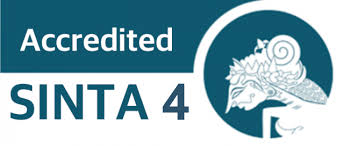The Differences in the Clinical Outcome Based on Nutritional Status in Patients with Acute Ischemic Stroke in Academic Hospital UGM
Farida Niken Astari(1*), Okta Haksaica Sulistyo(2), Lisa Rosyida(3), Aprillia Dewi ANP(4), Larasati Eka Putri(5)
(1) Academic Hospital Universitas Gadjah Mada
(2) Academic Hospital Universitas Gadjah Mada
(3) Academic Hospital Universitas Gadjah Mada
(4) Academic Hospital Universitas Gadjah Mada
(5) Academic Hospital Universitas Gadjah Mada
(*) Corresponding Author
Abstract
Background: The prevalence of stroke in Indonesia according to Basic Health Research (RISKESDAS) 20131 was 7%, increasing to 10.9% in the Basic Health Research (Riskesdas) 20182. Malnutrition is a kind of complication which stroke patients often experience. Complications that often arise in stroke patients are malnutrition. The impact of hospital malnutrition increases patients' length of stay and disease complications.
Objective: To determine the differences in clinical outcomes and length of stay in patients with acute ischemic stroke based on nutritional status at Academic Hospital UGM.
Research Methodology: The research used a retrospective cohort design with purposive sampling. All respondents were selected because they met the inclusion criteria. The respondents' data were taken from medical records of inpatients at the UGM Academic Hospital from January to December 2019. Data analysis was analyzed by using the Kruskal Wallis test because the data were not normally distributed.
Results: The result showed that stroke was more common in men (54.3%) with an average age of 60-74 years (55.5%). After being hospitalized, most of the patients' condition was improved (89%) with a no-risk screening score (85.5%). The nutritional status in stroke patients is good (44.5%). The length of stay (LOS) of stroke patients mainly was 4-7 days (75.7%) with an average NIHSS score of 5-15 or moderate (47.4%). The statistical test showed a value of p <0.05 to assess the difference in clinical outcomes of LOS and NIHSS scores on nutritional status.
Conclusion: There were differences in clinical outcomes in LOS and NIHSS scores based on the nutritional status of acute ischemic stroke patients. Patients with poor nutritional status had higher LOS and NIHSS scores, followed by normal nutritional status and overweight status.
Keywords: Acute Ischemic Stroke, clinical outcome, nutritional status
Full Text:
PDFReferences
Amalia L, Arsanti F, Megawati. 2017. Hubungan Luaran Subjective Global Assessment (SGA) dengan Derajat Keparahan Stroke Association Between Subjective Global Assessment (SGA) Outcomes and Stroke Severity. Jurnal Ilmiah Keperawatan IMELDA. 3(1): 247-252. Amiman RC, Tumboimbela MJ, Kembuan MAHN. 2016. Gambaran length of stay pada pasien stroke rawat inap di RSUP Prof. Dr. R. D. Kandou Manado periode Juli 2015-Juni 2016. Jurnal e-Clinic (eCl). 4(2). Amiman RC, Tumboimbela MJ, Kembuan MAHN. 2016. Gambaran length of stay pada pasien stroke rawat inap di RSUP Prof. Dr. R. D. Kandou Manado periode Juli 2015-Juni 2016. Jurnal e-Clinic (eCl). 4(2). Darmapadmi LPK. 2017. Analisis Determinan Lama Rawat Inap Pasien Stroke Di Rumah Sakit Umum Daerah Klungkung Menggunakan Metodekesintasan. Skripsi. Bali (ID): Universitas Udayana. Depkes. 2018. POTRET SEHAT INDONESIA DARI RISKESDAS 2018. www.depkes.go.id. Dianggra PS, Subagio HW, Himawan MRA. 2018. Lama Pencapaian Target Energi Dalam Masa Perawatan Pasien Stroke. JNH (Journal of Nutrition and Health). 6 (2): 57-64. Handayani D, Dominica D. 2018. Gambaran Drug Related Problems (DRP’s) pada Penatalaksanaan Pasien Stroke Hemoragik dan Stroke Non Hemoragik di RSUD Dr M Yunus Bengkulu. Jurnal Farmasi Dan Ilmu Kefarmasian Indonesia. 5(1): 36-44. Kasim VN, Pateda SM, Hadju V, Jafar N. 2017. Suplementasi ekstrak albumin ikan gabus terhadap status gizi dan imunitas pasien stroke. Jurnal Gizi Klinik Indonesia. 13(3): 91-98. Kemenkes RI. 2018. Hasil Utama Riskesdas 2018. Jakarta : Badan Penelitian dan Pengembangan Kesehatan Kemenkes RI. Khudin AM. 2014. Hubungan Kadar Gula Darah Sewaktu Dengan Kejadian Stroke Iskemik Ulang Di Rumah Sakit Umum Daerah Sukoharjo. Naskah Publikasi. Surakarta (ID): Universitas Muhammadiyah Surakarta. Ladecola C, Philip BG. 2004. Hypertension, Angiotensin, and Stroke: Beyond Blood Pressure. Stroke American Heart Association Journal. 35: 348-50. Meidarahman AP, Fakhrurrazy , Triawanti. 2019. Hubungan Status Nutrisi saat Masuk Rumah Sakit dengan Outcome pada pasien Stroke Iskemik. Homeostasis. 2(1): 107-112. Mutiarasari D. 2019. Ischemic Stroke: Symptoms, Risk Factors, And Prevention. Jurnal Ilmiah Kedokteran. 6(1): 60-73. Nababan T, Pitoyo CW, Harris S, Rumende CM. 2018. Uji Validasi Skor A2DS2 sebagai Prediktor Insiden. Jurnal Penyakit Dalam Indonesia. 5(3): 123-128. Pramadiaz AT, Fadil M, Mulyani H. 2016. Hubungan Faktor Risiko Terhadap Kejadian Sindroma Koroner Akut pada Pasien Dewasa Muda di RSUP Dr. M. Djamil Padang. Jurnal Kesehatan Andalas. 5(2) : 330-337. Qurbany ZT, Wibowo A. 2016. Stroke Hemoragik e.c Hipertensi Grade II. Jurnal Medula Unila. 5(6): 114-118 Racosta JM dkk. 2014. Stroke Severity Score based on Six Signs and Symptoms The 6S Score: A Simple Tool for Assessing Stroke Severity and In-hospital Mortality. Journal Of Stroke. 16(3): 178-183. Ritonga EP. 2017. Gambaran Status Gizi pada Pasien Stroke Pasca Rawat Inap di RA IV Neurologi RSUPH Adam Malik Medan. Jurnal Ilmiah Keperawatan IMELDA. 3(1): 247-252. Skolarus et al, 2014. Association of Body Mass Index and Mortality After Acute Ischemic Stroke. Circ Cardiovasc Qual Outcomes;7:64-69.
Article Metrics
Refbacks
- There are currently no refbacks.
Copyright (c) 2023 Academic Hospital Journal

This work is licensed under a Creative Commons Attribution-ShareAlike 4.0 International License.
Currently, Academic Hospital Journal indexed by:

View My Stats

This work is licensed under a Creative Commons Attribution-ShareAlike 4.0 International License





.png)


